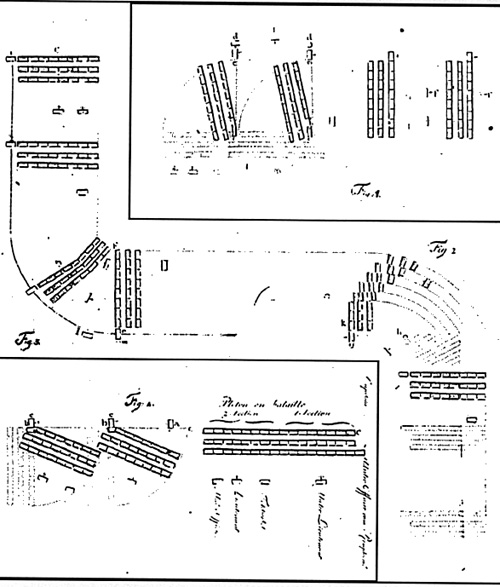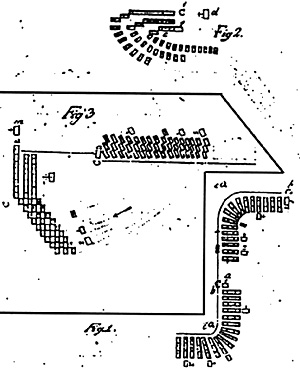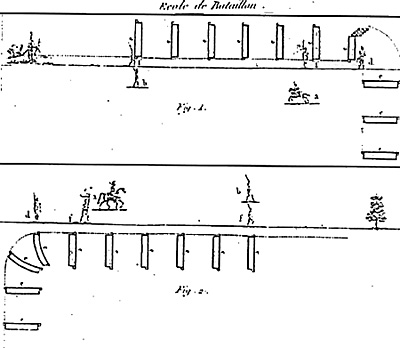Règlement Concernant l'Exercice et les Manouevres de l'Infanterie de Premier Août 1791
The Règlement 1791 specifies four cadences. All evolutions were supposed to be conducted at the 120 pace to the minute pas de charge, as described in an earlier article. The company formed a tactical sub-unit called a peleton, two of which comprised a division. Each peleton was further divided into two sections. A battalion usually consisted of nine companies prior to 1808 and six afterwards.
Wheeling with a Moving Pivot - un peleton marchant en colonne par section, qui change de direction de côte opposé au guide (a company marching in column of sections, changing direction on the flank opposite to the marker). [12]
The part of the Règlement 1791 from which this is taken is that dealing with instruction of the soldier under training. Elsewhere it is described and illustrated being used in multi sub-unit and unit environments. It is called a 'conversion', which means a wheel in a military context, in this case with a moving pivot shown here as a change of direction to the right, with the marker on the left. It could be executed to either flank as required. In this manoeuvre the cautionary command was "A droit conversion", (To the right wheel) followed by the executive "Marche."
Whereupon the man on the pivot flank took short paces of six inches, maintaining the cadence, moving from the pivot point in an arc, thus freeing it for the following rank. The man on the wheeling flank maintained the length of pace and cadence whilst bringing the rank round onto the new alignment. The text also shows that a characteristic of this manoeuvre was that the ranks were allowed to bend during the process which appears unique to the French regulations.
Once facing the required direction the order, "en avant" ("forward") was given, followed by, "Marche." This is shown at Fig 3 to Illustration 8, below.

Forming - Un peleton marchant en colonne par section, qui change de direction de côte du guide (a company marching in column of sections, changing direction on the flank of the marker). [13]
This manoeuvre is shown here being conducted to the left. The cautionary command was "Tournez à gauche" ("Turn to the left") the executive, delivered on arrival at the point where the manoeuvre was to take place, "Marche".
On receipt of the executive command the flank marker made a pivot to the indicated flank and maintained the pace and cadence. At the same time the remainder inclined to the left or right, by advancing the right or left shoulder respectively, and marched individually onto the new alignment at the Pas de Charge. This manoeuvre is shown at Fig 3 to Illustration 8, above. [14]
Forming by files could also be executed on the head by a column of files, thus producing a line to the front. This is shown at Illustration 9, Fig 3, below. [15]

The command was, "Par peleton en ligne." ("By platoon in line"), "Marche" followed by the executive "Marche". To form a line to the left flank, a column of files with its right in front need only execute a left turn to that direction. To deploy to the right in such a manner, however, would produce a line with its right flank standing on the left. To overcome this the column formed to the right on the right file and the remainder passed behind it falling in on its left. An example is shown at Illustration 9 Fig 2, above. The command was, "Sur la droite par file en bataille", ("Form line on the right by file). "Marche."
This method of forming to a flank ensured that the right flank remained on the right when the section stood in line. [16] The principle could be extended to columns of sub-units and will be examined later in the section on Austria.

Other examples of the principles at work at unit level are shown at Illustration 10, above, where a battalion consisting of two grenadier peletons and eight fusilier peletons is shown in colonne par peletons conducting a left form at Fig 1, and a right wheel at Fig 2. [17]
Wheel Continued
This article appears in MagWeb (Magazine Web) on the Internet World Wide Web.
Introduction
Life Before Cadence
Wheeling With a Stationary Pivot
Wheeling With a Moving Pivot
The Regulations: France
The Regulations: Prussia
The Regulations: Austria
The Regulations: Britain and KGL
Summary and Conclusions
Footnotes
[12] Règlement Concernant l'Exercice et les Manoeuvres de l'Infanterie de Premier Août 1791, Paris, n.d. Planche VIII, Fig 3, l'Ecole du soldat pp86-87, and l'Ecole de peleton p135.
[13] Règlement 1791. op.cit. Planche VIII, Fig 2, l'Ecole du soldat p88 and l'Ecole de peleton p 134.
[14] Reglement das Exercitium und die Manövres der Französischen Infanterie betreffend vom 1sten August 1791 Aus dem Französischen für die Königlich-Westfalischen Regimenter. Braunschweig, 1812, p134 and plX Fig2.
[15] Ibid. PlIX.
[16] Règlement 1791. op. cit. pp119-126
[17] Règlement 1791. op.cit. Planche XII, Ecole de Bataillon, p123 and 131.
Back to Table of Contents -- First Empire #28
© Copyright 1996 by First Empire.
Other military history articles and gaming articles are available at http://www.magweb.com